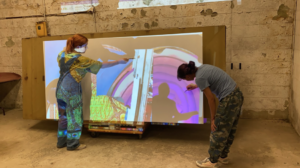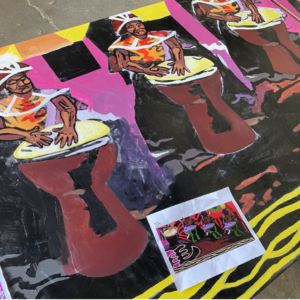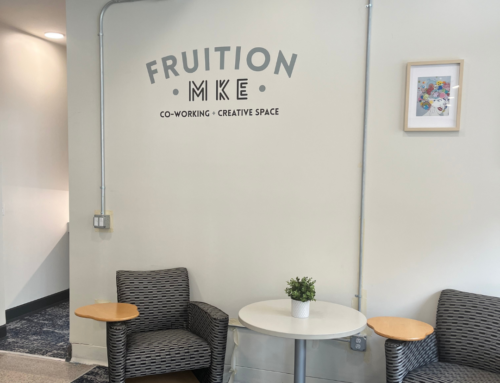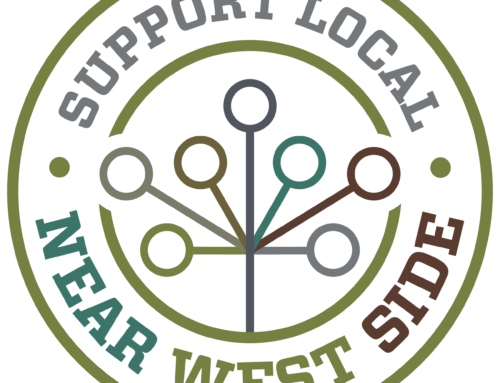In early 2021, Near West Side Partners (NWSP) secured federal funding for six community improvement projects– also known as Action Activities– to implement in the spring and complete within one year. This will include the installation of eight new murals designed by Milwaukee residents such as Brad Bernard, muralist and professor at the Milwaukee Institute of Art and Design (MIAD).
For the past two weeks, Brad and students from MIAD have been working on a mural for the Wisconsin African American Women’s Center at 3020 W. Vilet Street. A Martin Drive resident of ten years, he learned about the organization in 2013 through their Sisters of Creativity event.

Above: The progress of the Wisconsin African American Women’s Center mural, which showcases two of its board members, including Executive Director Josephine Hill.
Murals have served as a tool to bring artists, businesses, and residents together to learn more about the community’s history and culture. To make properties more attractive, artists will design something, then coordinate with the owners and the neighborhood association to get feedback and hear from community members about what’s missing from their original idea. By making the process more inclusive, “no one feels like they have anything imposed on them and everyone has an invested interest,” Brad explained.
After the social unrest that occurred last summer, Brad sees murals as a way for businesses and property owners to support artists and help raise awareness of local issues. It also helps students establish goals for their art.

Above: Students use a projector to trace Brad’s design for a mural of Frederick Olmsted, architect of Washington Park.
“The larger vision is to seize the moment and take the purpose of murals back. They should always be informative, uplifting, or saying something, to make people aware,” Brad said.
He also values art as a community resource and sets a goal to make it more accessible throughout the neighborhood. In a time where most murals are “reactionary” or “insignificant,” Brad seeks to create art that’s “historically and culturally relevant.”
Once all the murals are put up, he hopes to add curb appeal and put up QR codes so people can learn the full history behind the project. He wants it to become “an outdoor public art gallery.”
Brad explained that people living in the neighborhood should be made aware of local history and culture and that art is a great outlet for informing and educating. By doing so, these murals serve a unique purpose by highlighting work done around the community.
“It’s important for people who live in these areas to be made aware of either something culturally or historically relevant… Because people could live in an area for almost all their life and not be aware of what’s around them,” He said, about the Hmong Friendship Association mural.
When talking about art’s role in NWSP’s community improvement goals, Brad said that building “a conscious dialogue about the richness and the culture of the area” through art helps residents better understand what the organization represents. Other social justice-related issues, such as NWSP’s focus on gentrification without displacement, can be a valuable mindset to have when painting and displaying murals.

Above: A closer look at the Wisconsin African American Women’s Center mural, which features detailed African drummers.
“Murals have the power to show the intermingling of current history with past history,” Brad said. “What better way to celebrate the long-committed residents of the area than by celebrating some of those individuals on the walls of the neighborhood?” He added.
Moving forward, Brad hopes that NWSP integrates art into more community initiatives. He hopes to see more arts facilities open to “create [opportunities] for artists to work outside the home and activate a space that would otherwise be empty,” he said. In addition, these goals will also help build a more “symbiotic relationship that will help stimulate the Near West Side.”
To learn more about Brad’s work and the upcoming mural project, you can visit his website or keep an eye out for the Westview Mural Tour on our social media. Special thanks to MIAD students Erika Schrauth and Hannah Davis for providing pictures and videos of the mural’s progress.




